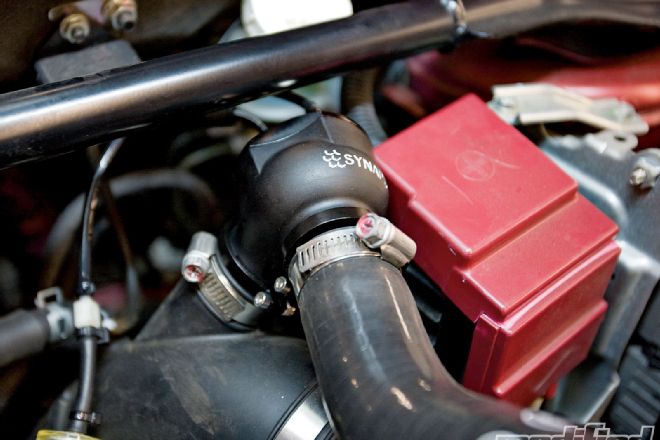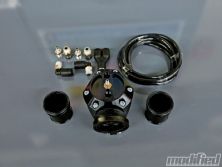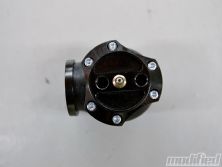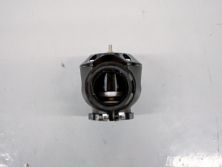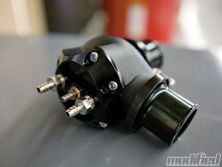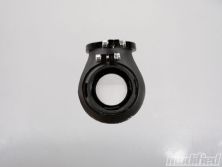Test Mule
'08 Mitsubishi Evo GS-R
Engine
2.0-liter 4B11 turbocharged 4-cylinder
Relevant Mods
AEM intake, AMS intercooler piping, Samco Sport recirculation hose, RRE tune
Key Features
• Compact size allows the Synchronic DV to fit in tight spaces
• High-flow valve design ensures quick response no matter the boost level
• BOV body is precision cast with aerospace-grade aluminum
• Black anodized surface finish preserve the OE look and feel
• Can be used in a push- or pull-type orientation with the ability to fully recirculate or vent-to-atmosphere
• Each assembly is pressure tested to withstand 60 psi
• Positive lock clamshell retainers are included to ensure a leak-free fitment
• Variety of flanges are available to fit many different applications
Proving Grounds
Description
The blow-off valve hasn't changed all that much in the past decade or so, but its function still remains the same: to discharge compressed air trapped in charged piping when the throttle plate closes, which prevents compressor surge and excessive wear on the turbocharger. However, there have been significant improvements in the design of blow-off valves by almost all the major manufacturers. They now seal much better, hold greater amounts of boost and do so while being much smaller than previous generations.
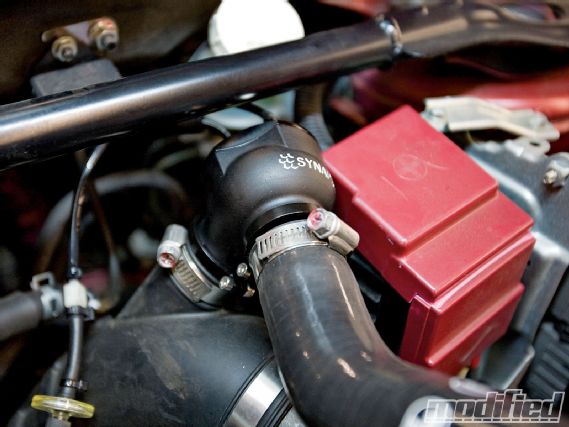 |
Synapse Synchronic Diverter Valve - Tech
|
Synapse Synchronic Diverter Valve - Tech
Take, for example, Synapse Engineering's newest BOV, the Synchronic Diverter Valve. It's the successor of the original Synchronic BOV that was larger and heavier in size. The Synchronic DV is much more compact and can be used in either push- or pull-type orientations, whereas the original version was a strictly pull-type setup.
Because of its compact design, the Synchronic DV can fit in tight engine bays where every inch of space counts. Don't think that its small package means it can't flow a lot of air; the investment-cast, aerospace-grade aluminum body and precision CNC'd actuator have been tested to withstand 60 psi and actuate within 25 milliseconds, resulting in extremely quick response and high-flow characteristics.
The Synchronic DV's clamp system allows for a quick, locking setup of either push- or pull-type orientation and the supplied quick connect fittings ensure a leak-free environment with the boost/vacuum hose.
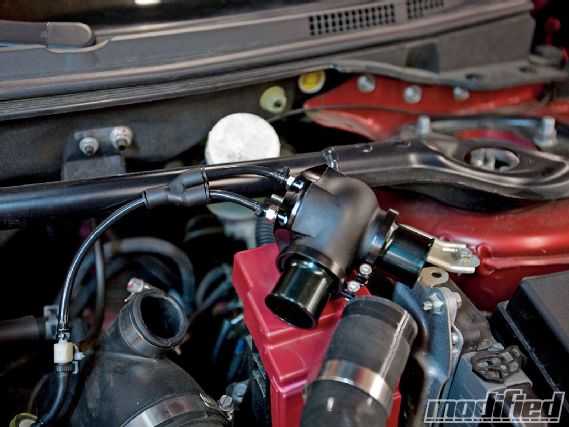 |
Synapse Synchronic Diverter Valve - Tech
|
Synapse Synchronic Diverter Valve - Tech
Results
Having already tested a few aftermarket BOVs on our Mitsubishi Evolution X project car with less than stellar results, we were curious to see if Synapse Engineering's Synchronic DV would provide similar OEM-like driving characteristics but with better consistency.
The biggest problem we encountered when trying other BOVs on the EVO was that the valve was too slow to release under light throttle. On the highway, a hiccup and stutter would occur whenever we would slightly lift off the gas pedal. This was tolerable for the first couple of drives, but soon became quite annoying. The reason behind the problem was a lack of adjustment in the BOV's internal spring, which was too stiff to release under low boost. Therefore, the OEM BOV was reinstalled.
Would the Synchronic DV suffer the same fate as its aftermarket counterparts, or would it perform just like stock? After several weeks of driving with the Synchronic DV, it proved to perform much better than any of the other BOVs we tested. Was it perfect? No, but there was no stuttering on the highway or in normal driving conditions. We could feel a slight hesitation under high-load, low-rpm acceleration when releasing the throttle, but we're not sure that the Synchronic DV is to blame. It could be an effect of the ECU trying to control the higher boost levels the turbo is pushing.
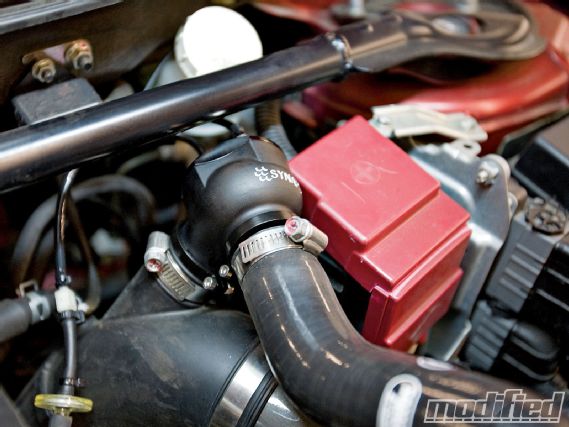 |
Synapse Synchronic Diverter Valve - Tech
|
Synapse Synchronic Diverter Valve - Tech
The Synchronic DV does a much better job of actually sealing than the OEM unit - we noticed our peak boost pressure rise 2 psi after installing it. That can only mean that the OEM BOV shows signs of leaking at boost levels over 28 psi because the Synchronic DV would peg 30 psi on our boost gauge. It's safe to say that if you plan on running boost in around that area, then an upgrade to a Synchronic DV is a wise decision.
Furthermore, the Synchronic DV has an adjustable screw that lets you set the stiffness of the spring, which releases the actuator and puts even more control in your hands as to what precise boost level you want the BOV to release.
Installation on the EVO X is a 5-minute affair, as the BOV is in an easy-to-locate spot. Putting the Synchronic DV together proved a bit cumbersome with just one person because the secure mounting flanges have to be pressed in and held while the clamps are tightened down. But with some quick hand acrobatics and a wrench, the Synchronic DV was ready to install. It's compact size is also a nice plus, as it dropped into the EVO's stock location without having to move any piping or rubbing against surrounding parts.
For those of you interested in the sound, we ran the Synchronic DV in a vent-to-atmosphere setup very briefly and it makes the typical PSSH noise that you commonly hear on vented BOVs. When plumbed into the intake, the sound is much more pronounced than stock, especially if you have an aftermarket intake. It's definitely not the loudest on the market, but we hope that sound isn't your main factor for purchasing a BOV.
Instead, if you focus on the other features that the Synchronic DV brings to the table, it's a worthy adversary for one of the top performing blow-off valves on the market.

